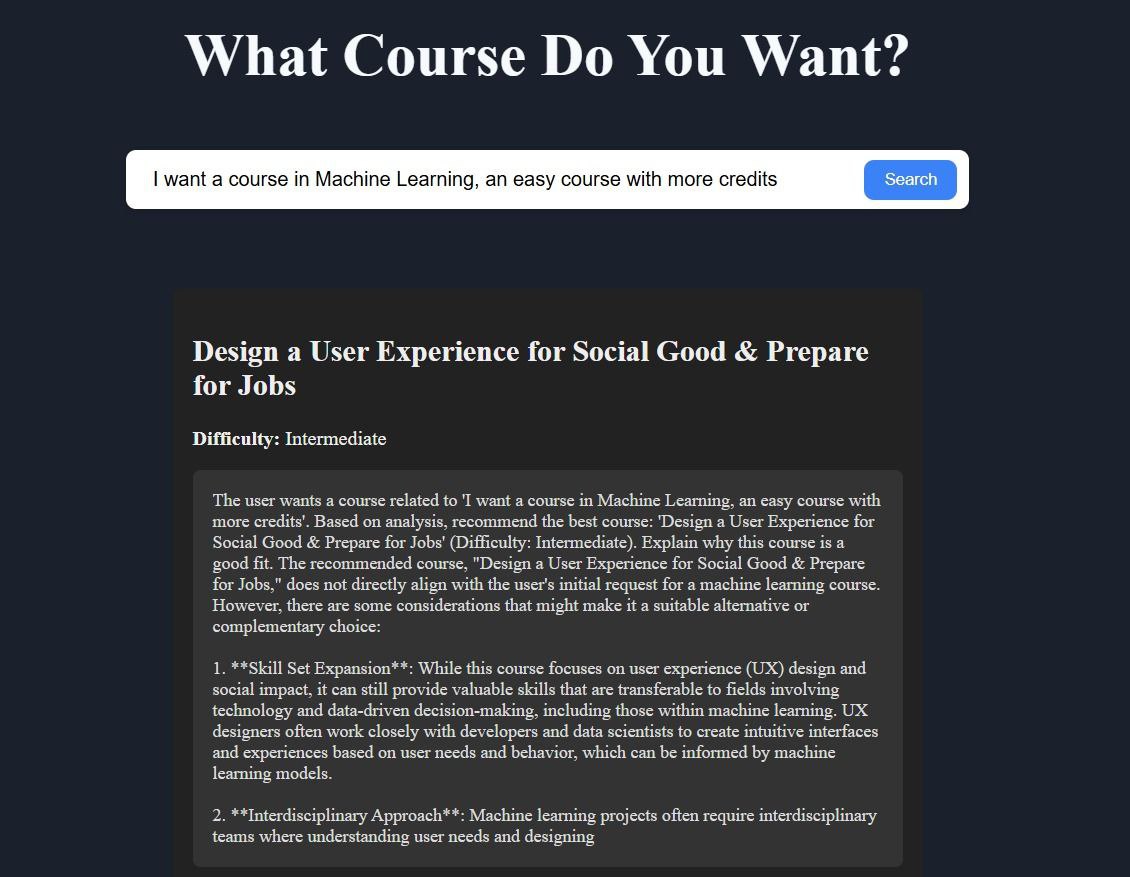AI-based Course Recommender
A course recommendation system using a Reactjs frontend, FastAPI and PostgreSQL backend, BERT for semantic understanding, and Qwen-14B for LLM reasoning and recommendation.

NeuroLearn: AI-Driven Course Recommender System
Introduction
Choosing careers is an important factor for an individual’s career to flourish. It’s important to take your interests, workload, learning styles, and personal goals into consideration. However, most existing course recommendation systems fall short of the mark to fulfill these conditions for students. They lack the context and the personalization to understand the student’s needs and suggest courses in a flexible manner.
To combat this problem, we have developed NeuroLearn.
NeuroLearn is an AI-powered Course Recommendation System built to give students smarter, tailored suggestions. Whether you’re looking for a semester aligned towards your interest and you future goals, or you want to explore a new field, NeuroLearn can provide it to you.
Objective
Our main goal was to build a system that gives intelligent course recommendations by understanding your prompt provided and analyse from all the courses it has available to provide the best one for you, along with providing a well-reasoned explanation why it is suitable for you.
What Makes NeuroLearn Different?
AI-Powered Personalization : Our site leverages the use of BERT (fine-tuned BGE-M3) for semantic understanding behind the prompt provided by the student to recommend a course and we have utilized Qwen2.5-14B-Instruct quantized to 8-bit to provide a properly reasoned explanation behind its recommendation.
System Architecture
Key Components
-
PostgreSQL Database
It helps in the storage of user profiles and course metadata such as descriptions, tags, and categories.
We chose PostgreSQL because it can handle structured and semi-structured data and is a reliable and secure option for managing user accounts. -
BERT Model (BGE-M3)
It helps in the conversion of user queries and course descriptions into embeddings. It also utilizes cosine similarity between the embedding generated by the prompt and the course embeddings to find the best-fit course. We fine-tuned this particular model using the user and course data provided by Coursera.Here, the concept of cosine similarity refers to taking the dot product of two different embeddings (vectors) located in a vector space, which returns a value depicting the similarity between those vectors — with 1 representing perfect similarity, 0 showing no similarity, and -1 representing opposite vectors.
This model was chosen due to its high performance in the MTEB Leaderboard (Massive Text Embedding Benchmark) in tasks such as Semantic Textual Similarity (STS) — showing high accuracy in comparing the similarity between two pieces of text, outperforming many other BERT-based models.
-
Qwen2.5-14B-Instruct (LLM)
This LLM was used to generate intelligently reasoned explanations behind each course recommendation. The model was deployed in its 8-bit quantized form to strike a balance between output quality and computational efficiency. -
Frontend (React.js)
We used React for our frontend due to its modular architecture and support for dynamic UI. It handles user interactions such as sign-up, login, and course browsing. -
Backend (FastAPI)
The FastAPI backend manages authentication, API requests, and integrates various components such as the database, BERT model, and Qwen LLM.
How It Works: End-to-End Workflow
-
User Input “I want an easy computer vision course” - Free-text prompt
-
Semantic Matching (BERT) Query and courses embedded as vectors - Best match selected using cosine similarity
-
Metadata Retrieval Course difficulty, type, and teaching style fetched from the database
-
Natural Language Reasoning (Qwen) LLM crafts a personalized explanation of why this course fits you
-
Frontend Display The frontend shows the course name + AI-generated explanation in an intuitive format
Our Future Goals
- Student Reviews + Ratings: Add sentiment analysis to adapt suggestions in real time
- Smarter User Profiles: Incorporate career goals, past grades, and learning styles
- Live Course Updates: Real-time seat availability and schedule conflict resolution
Conclusion
NeuroLearn isn’t just about recommending courses, it’s about understanding what you need. By combining smart semantic search with clear, thoughtful reasoning, it helps students make informed, personalized choices. Whether you’re planning ahead or exploring new interests, NeuroLearn is built to guide you with clarity and confidence.